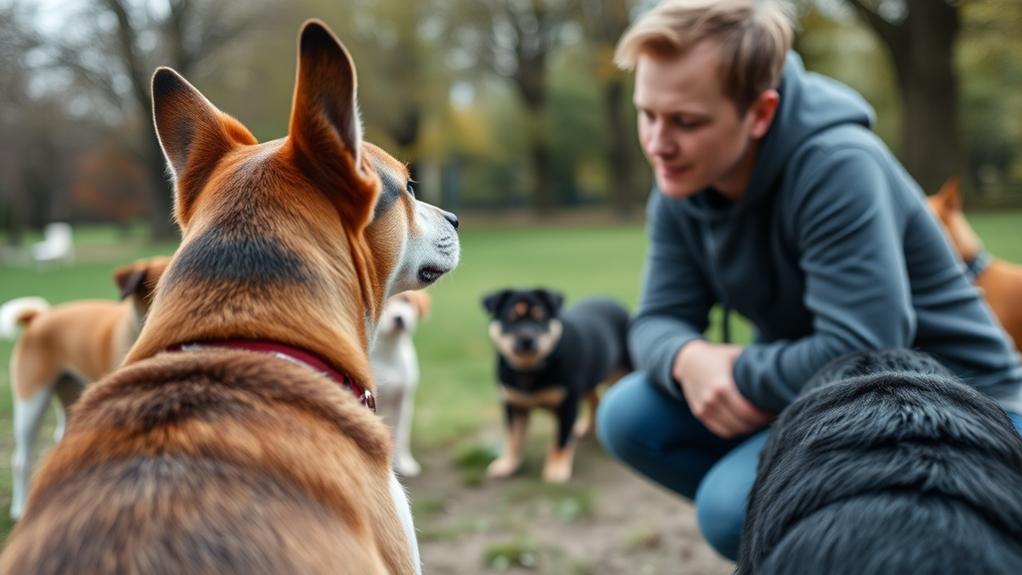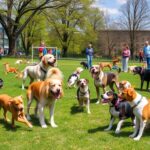To effectively train and socialize your dog, start with basic commands like "sit" and "stay," using positive reinforcement to reward good behavior. Establish a consistent routine for feeding, walks, and playtime to create a sense of security. Socialize your dog early by exposing them to various people and environments. Keep training sessions short, around 5 to 10 minutes, to maintain focus. Use play as a reward and pay attention to your dog's body language to adjust your approach. If you're facing challenges, don't hesitate to seek professional help. There's plenty more to discover about enhancing your training experience.
Start With Basic Commands
When you begin training your dog, mastering basic commands is essential for a well-behaved companion. Start with the fundamentals: "sit," "stay," "come," "down," and "leave it." These commands form the foundation of good behavior and help establish communication between you and your dog.
Begin each session in a quiet area with minimal distractions. Use a consistent tone and clear hand signals to reinforce your commands. For instance, when you say "sit," gently place your dog's rear on the ground if needed. Repeat the command and praise your dog as soon as they comply. This helps them associate the word with the action.
Practice regularly but keep sessions short—about 5 to 10 minutes—so your dog stays engaged and doesn't lose interest. Gradually increase the difficulty by introducing distractions or performing commands in different environments. Over time, your dog will become more reliable in responding to commands.
Use Positive Reinforcement

Positive reinforcement is a powerful tool in dog training that encourages desired behaviors through rewards. When your dog performs a command correctly or exhibits good behavior, rewarding them immediately with treats, praise, or playtime reinforces that action. This method not only strengthens the bond between you and your dog but also promotes a positive learning environment.
To effectively use positive reinforcement, keep the rewards consistent and immediate. If your dog sits on command, give them a treat right away. This helps them connect the behavior with the reward. Be mindful of the timing; the quicker you reward them, the better they'll understand what they did right.
It's vital to vary the rewards as your dog learns. While treats are great, sometimes a favorite toy or extra affection can be just as motivating. Also, remember to be patient. Not every dog learns at the same pace, so it's imperative to stay encouraging and supportive.
Lastly, avoid using negative reinforcement, as it can create fear or anxiety, making training less effective. Focus on positive experiences, and you'll see your dog thrive in their training journey.
Establish a Routine
Establishing a routine is key to helping your dog feel secure and understand what's expected of them. Dogs thrive on consistency, so setting a regular schedule for feeding, walks, and playtime will make them feel more comfortable in their environment. Start by feeding your dog at the same times each day. This consistency helps regulate their digestion and reduces anxiety.
Next, incorporate daily exercise into your routine. Whether it's a morning walk or an afternoon play session, regular physical activity is essential for your dog's health and happiness. Aim for a balanced mix of exercise and mental stimulation through games and training exercises.
Training sessions should also be part of your routine. Keep these short and engaging, ideally around 5 to 10 minutes, to maintain your dog's interest. Consistency in commands and cues reinforces learning.
Socialize Early and Often

Socializing your dog early and often is essential for their development and well-being. The more experiences your dog has with different people, animals, and environments, the more confident and well-adjusted they'll become. Start socialization as soon as you bring your puppy home, ideally between 3 to 14 weeks of age, when they're most receptive to new experiences.
Take your pup out to parks, pet stores, and other dog-friendly places. Encourage positive interactions with people and different dogs, but always supervise these encounters. If your dog seems nervous, don't force the situation; instead, give them time to adjust. Use treats and praise to reinforce positive behavior, helping your dog associate new experiences with good outcomes.
Keep Training Sessions Short

When it comes to dog training, keeping sessions short can make a big difference in your pup's ability to learn and retain new commands. Dogs, especially young ones, have limited attention spans. If you push them to train for too long, they might become bored or frustrated, which can hinder their learning. Aim for sessions that last about 5 to 10 minutes. This keeps your pup engaged and enthusiastic to participate.
During these short sessions, focus on one command or skill at a time. This focused approach helps your dog grasp the concept without feeling overwhelmed. When your pup successfully follows a command, reward them immediately with praise or treats. This reinforces positive behavior and encourages them to learn more.
You can also break longer training routines into several short sessions throughout the day. This not only prevents fatigue but also provides multiple opportunities for your dog to practice and improve. Remember, consistency is key, so try to incorporate training into your daily routine. Keeping your training sessions short makes learning enjoyable for both you and your dog, leading to a more successful training experience overall.
Be Patient and Consistent

Training your dog requires more than just short, focused sessions; it demands patience and consistency. You might not see immediate results, and that's perfectly normal. Dogs learn at their own pace, so it's pivotal to stay committed to your training routine. Every dog is unique, and understanding your pet's learning style will help you adapt your approach.
Consistency is key when it comes to commands and expectations. Use the same verbal cues and hand signals each time, so your dog doesn't get confused. If you or your family members use different commands, it can create misunderstandings. Make sure everyone is on the same page.
Additionally, be patient when your dog doesn't grasp a command right away. Frequent practice and repetition build their confidence and understanding. Celebrate small victories, and don't hesitate to reward your dog with praise or treats when they perform well. This positive reinforcement strengthens your bond and encourages them to keep trying.
Gradually Introduce New Environments

As you continue your dog's training, gradually introducing them to new environments is essential for their socialization. Start by taking your pup to different locations, like parks, sidewalks, or even a friend's backyard. These new experiences expose them to various sights, sounds, and smells, helping them become well-adjusted and confident.
Begin with quieter places, allowing your dog to explore without feeling overwhelmed. Observe their reactions; if they seem anxious, give them time to acclimate. You can gradually increase the level of stimulation by visiting busier areas, such as dog parks or pet-friendly stores.
Always keep your dog on a leash during these outings to maintain control. Encourage positive interactions with other dogs and people, but don't force them. Allow your pup to approach new friends at their own pace.
Make each outing a fun adventure. Bring along their favorite toys or treats to create positive associations with new environments. Remember, the goal is to help your dog feel secure and happy while experiencing the world around them. This gradual exposure will build their confidence and reduce anxiety, ensuring they thrive in various situations.
Use Play as a Reward

Incorporating play as a reward can greatly enhance your dog's training experience. Dogs naturally enjoy playtime, and using it as a reward helps reinforce desired behaviors. When your dog successfully follows a command, immediately follow up with a fun game, like fetch or tug-of-war. This connection between good behavior and playtime will motivate your dog to repeat those actions.
To effectively use play as a reward, select engaging activities your dog loves. If your dog enjoys chasing a ball, use that as a reward for completing tasks. Timing is pivotal; deliver the reward right after the behavior you want to reinforce. This clear association helps your dog understand that playtime is a direct result of their good behavior.
Keep in mind that every dog is different. Some may prefer interactive games, while others might respond better to solo play. Be observant and adjust your rewards accordingly. Also, remember to keep play sessions short and energetic to maintain your dog's interest. By making play a consistent and enjoyable reward, you'll not only enhance training but also strengthen the bond you share with your furry companion.
Monitor Body Language

Monitoring body language is critical for understanding your dog's feelings and reactions during training. Dogs communicate a lot through their posture, facial expressions, and movements. By paying close attention, you can adjust your training approach to guarantee your dog feels comfortable and confident.
Tail Position: A wagging tail can indicate excitement, but a low or tucked tail often signals fear or anxiety. Understand the context to interpret these signals accurately.
Ears: Ears held back can show submission or fear, while perked ears indicate alertness or curiosity. Observing your dog's ear position can give you insight into their mood.
Body Stiffness: If your dog appears tense or stiff, it may be feeling threatened or uncomfortable. On the other hand, a relaxed body indicates contentment and readiness to engage.
Seek Professional Help if Needed

Sometimes, you might find that your dog's behavior isn't improving despite your best efforts. When this happens, it's vital to consider seeking professional help. Training a dog can be a complex task, and sometimes, you need an experienced hand to guide you. Professional trainers can offer tailored advice and strategies that align with your dog's unique temperament and needs.
You might feel overwhelmed, especially if your dog displays aggressive behavior or extreme anxiety. A professional can assess the situation objectively, provide effective training techniques, and help you understand your dog's triggers. They can also assist with socialization, teaching your dog how to interact appropriately with other pets and people.
Don't hesitate to reach out for help; doing so can save you time and frustration. Look for trainers who use positive reinforcement methods, as they're more likely to create a trusting relationship with your dog. Always check their credentials and reviews before committing. Remember, seeking professional help isn't a sign of failure; it shows your dedication to providing the best for your furry friend. With the right guidance, you'll be well on your way to a happier, well-behaved companion.
Conclusion
By following these essential tips, you'll set your dog up for success in training and socialization. Remember to start with the basics, use positive reinforcement, and keep those sessions fun and engaging. Socializing your pup early and often will help them become a well-adjusted adult dog. Stay observant of their body language, and don't hesitate to seek professional help if you need it. With patience and consistency, you'll build a strong bond with your furry friend!



